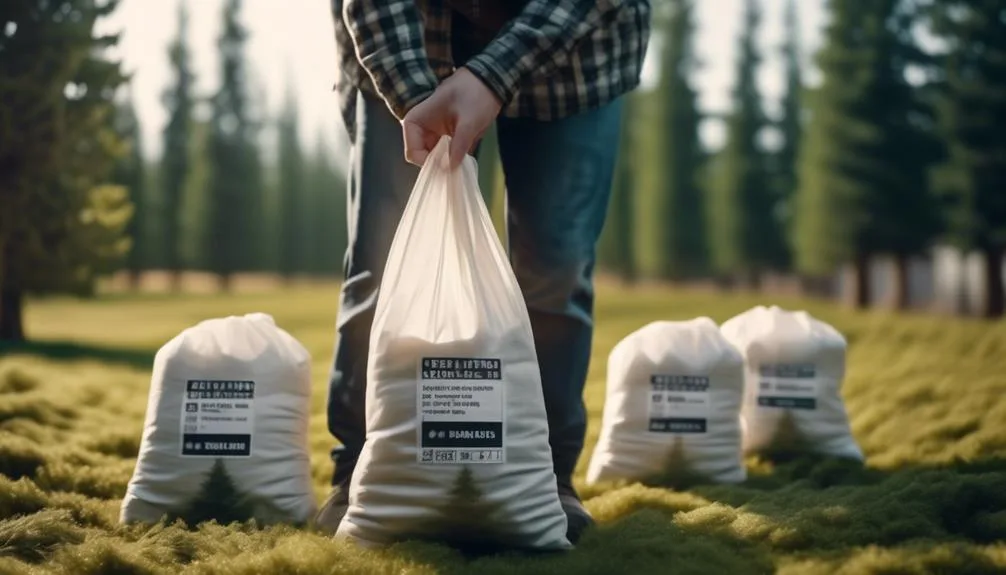Choosing the right fertilizer for your spruce trees is crucial for a healthy landscape. With many options available, it can be overwhelming. Understanding the specific nutrient needs and the factors that influence proper fertilization can help you make an informed decision.
By considering the type of fertilizer, application methods, and timing, you can provide your spruce trees with the essential nutrients they need. Whether you're new to gardening or experienced, selecting the right fertilizer is key to fostering a flourishing outdoor space.
Understanding Spruce Tree Nutrient Needs
To ensure the health and vitality of your spruce trees, it's crucial to understand their specific nutrient needs and how to fulfill them effectively.
Soil testing is an essential first step in identifying any nutrient deficiencies that may be affecting your spruce trees. By understanding the specific deficiencies, you can then select the right fertilizer to address these issues.
Nitrogen, phosphorus, and potassium are key nutrients for spruce trees, and a soil test can help determine which, if any, of these elements are lacking.
Once you have this information, you can choose a fertilizer that's specifically formulated to address these deficiencies. This targeted approach ensures that your spruce trees receive the precise nutrients they require for optimal growth and health.
Evaluating Fertilizer Options
Understanding the specific nutrient deficiencies of your spruce trees will guide your evaluation of fertilizer options to ensure their optimal health and growth. When comparing formulations, consider the nutrient availability and the specific needs of your spruce trees.
Look for fertilizers that provide a balanced mix of nitrogen, phosphorus, and potassium, as well as essential micronutrients such as iron, manganese, and zinc. Assess the release characteristics of the fertilizers as well; slow-release formulations can provide a steady supply of nutrients over an extended period, promoting sustained growth and health.
Additionally, consider the pH requirements of your spruce trees and choose a fertilizer that aligns with those needs. By carefully evaluating the nutrient content, release characteristics, and pH compatibility of different fertilizer options, you can select the best one to support the thriving growth of your spruce trees.
Factors for Proper Application
Consider the timing, method, and frequency of fertilizer application to ensure optimal nutrient uptake and utilization by your spruce trees.
Proper timing is crucial for fertilizer application to spruce trees. It's best to fertilize in early spring before new growth begins to support the tree's development.
Soil testing is essential to determine the specific nutrient requirements of your spruce trees. Conduct a soil test to evaluate the existing nutrient levels and pH, which will guide you in selecting the right fertilizer and determining the appropriate application rate.
Applying fertilizer using the broadcast method ensures an even distribution of nutrients across the root zone.
Lastly, maintain a consistent fertilization schedule to meet the nutritional needs of your spruce trees throughout the growing season.
Timing and Frequency of Fertilization
Assessing the timing and frequency of fertilization is crucial for ensuring that your spruce trees receive the necessary nutrients for healthy growth and development. Proper timing and frequency are essential for maximizing nutrient absorption and ensuring the health of your trees. Consider the soil composition and the specific needs of your spruce trees when determining the timing and frequency of fertilization. Here's a simple guide to help you understand the basics:
| Timing | Frequency | Guidelines |
|---|---|---|
| Early spring | Annually | Apply a balanced fertilizer to support new growth |
| Late fall | Biennially | Provide nutrients before the winter dormancy |
| Mid-summer | As needed | Supplement with additional nutrients if necessary |
Understanding the nutrient absorption and the soil composition of your area will help you make informed decisions about the timing and frequency of fertilization for your spruce trees.
Monitoring Spruce Tree Response
To gauge the effectiveness of the fertilization, observe the spruce tree's response to the nutrients provided. Here are four key steps to monitor your spruce tree's response:
- Measuring Growth: Regularly measure the tree's height and the diameter of its trunk to track any changes over time. This will help you assess the tree's overall growth and health.
- Foliage Examination: Keep an eye on the color, density, and overall condition of the tree's foliage. Changes in foliage can indicate the tree's response to the fertilizer application.
- Soil Testing: Conduct periodic soil tests to monitor the nutrient levels in the soil. This will help you determine if the tree is receiving adequate nutrients from the soil or if additional fertilization is needed.
- Observation of New Shoots: Pay attention to the development of new shoots and branches. Increased growth in these areas can indicate a positive response to the fertilizer.
Monitoring these aspects will provide valuable insights into the impact of the fertilization on your spruce trees.
Conclusion
Incorporate the nutrient needs and evaluation of options to choose the most suitable fertilizer for your spruce trees. Consider soil composition, pH, and proper application techniques.
Continuously monitor your trees' response for thriving results. With the right care and fertilizer, your spruce trees will flourish for years.
Happy nurturing!

My interest in trees started when I first saw the giant sequoias in Yosemite.
I was a teenager then, and I remember thinking, “I need to learn more about this.”
That moment stuck with me.
A few years later, I went on to study forestry at Michigan Tech.
Since graduating, I’ve worked in a mix of hands-on tree care and community education.
I’ve spent over ten years helping people understand how to plant, maintain, and protect the trees in their neighborhoods.
I don’t see trees as just part of the landscape.
They are living things that make a real difference in our daily lives.
